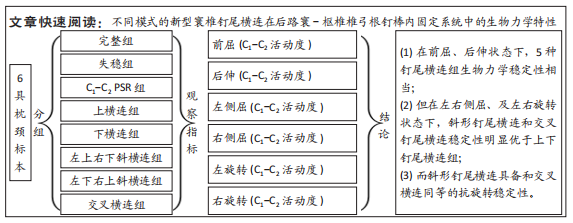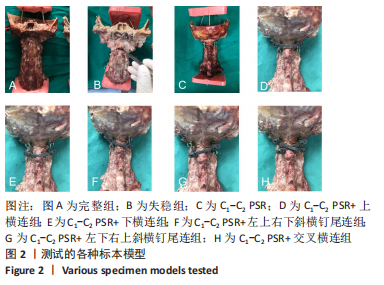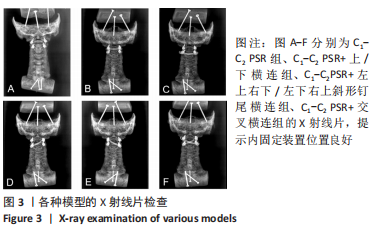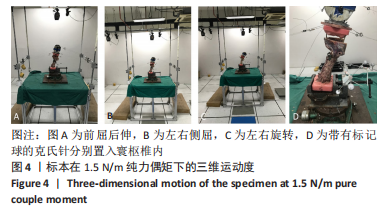[1] OUYANG B, ZOU X, LUO C, et al. Finite Element Analysis of Horizontal Screw-Screw Crosslink Used in C1-C2 Pedicle Screw-Rod Fixation. Med Sci Monit. 2021;27:e932026.
[2] SHAO J, GAO Y, GAO K, et al. Comparison of imaging parameters pre- and post- reductive procedure for atlantoaxial dislocation via posterior fixation using pedicle screw and rod: a cross-sectional study. BMC Musculoskelet Disord. 2019;20:451.
[3] BURKHARDT BW, PODOLSKI W, PITZEN TR, et al. The Feasibility of C1-C2 Screw-rod Fixation in the Children 5 Years of Age and Younger. J Pediatr Orthop. 2021;41:e651-e658.
[4] TATTER C, FLETCHER-SANDERSJÖÖ A, PERSSON O, et al. Fluoroscopy-Assisted C1-C2 Posterior Fixation for Atlantoaxial Instability: A Single-Center Case Series of 78 Patients. Medicina (Kaunas). 2022;58:undefined.
[5] UNNI C, PETTAKKANDY V, P AJ, et al.Atlantoaxial Stabilization by Posterior C1 and C2 Screw-Rod Fixation for Various Pathologies: Case Series and Comprehensive Review of Literature. J Neurosci Rural Pract. 2021;12(2): 228-235.
[6] ZHANG J, ZHANG Z, ZHU Y, et al. C1 Titanium Cables Combined with C2 Pedicle Screw-Rod Fixation for Atlantoaxial Instability Not Suitable for Placement of C1 Screws. World Neurosurg. 2018;120:e453-e456.
[7] SHI L, SHEN K, DENG R, et al. Novel unilateral C1 double screw and ipsilateral C2 pedicle screw placement combined with contralateral laminar screw-rod fixation for atlantoaxial instability. Eur Spine J. 2019;28(2):362-369.
[8] SHEN K, DENG Z, YANG J, et al. Biomechanical study of novel unilateral C1 posterior arch screws and C2 laminar screws combined with an ipsilateral crossed C1-C2 pedicle screw-rod fixation for atlantoaxial instability. Arch Orthop Trauma Surg. 2017;137(10):1349-1355.
[9] PATKAR SV. New entry point for C2 screw, in posterior C1-C2 fixation (Goel-Harm’s technique) significantly reducing the possibility of vertebral artery injury. Neurol Res. 2016;38(2):93-97.
[10] WANG HW, YIN YH, LI T, et al. Effects of transverse connector on reduction and fixation of atlantoaxial dislocation and basilar invagination using posterior C1-C2 screw-rod technique. Spine J. 2019;19(12):1995-2002.
[11] DU YQ, LI T, MA C, et al.Biomechanical evaluation of two alternative techniques to the Goel-Harms technique for atlantoaxial fixation: C1 lateral mass-C2 bicortical translaminar screw fixation and C1 lateral mass-C2/3 transarticular screw fixation. J Neurosurg Spine. 2020;17:1-7.
[12] DU JY, AICHMAIR A, KUEPER J, et al. Biomechanical analysis of screw constructs for atlantoaxial fixation in cadavers: a systematic review and meta-analysis. J Neurosurg Spine. 2015;22(2):151-161.
[13] Li T, Ma C, Du YQ, et al. The Role of Transverse Connectors in C1-C2 fixation for Atlantoaxial Instability: Is It Necessary? A Biomechanical Study. World Neurosurg. 2020;140:e212-e218.
[14] TAN J, LI L, SUN G, et al. C1 lateral mass-C2 pedicle screws and crosslink compression fixation for unstable atlas fracture. Spine (Phila Pa 1976). 2009; 34(23):2505-2509.
[15] TESSITORE E, MOMJIAN A, PAYER M. Posterior reduction and fixation of an unstable Jefferson fracture with C1 lateral mass screws, C2 isthmus screws, and crosslink fixation: technical case report. Neurosurgery. 2008;63(1 Suppl 1):ONSE100-1; discussion ONSE101.
[16] SIM HB, LEE JW, PARK JT, et al. Biomechanical evaluations of various C1-C2 posterior fixation techniques. Spine. 2011;36(6):E401.
[17] GEBAUER M, BARVENCIK F, BRIEM D, et al. Evaluation of anatomic landmarks and safe zones for screw placement in the atlas via the posterior arch. Eur Spine J. 2010;19(1):85-90.
[18] RESNICK DK, BENZEL EC. C1-C2 pedicle screw fixation with rigid cantilever beam construct: case reportand technical note. Neurosurg. 2002;50(2):426-428.
[19] EBRAHEIM N, ROLLINS JR JR, XU R, et al. Anatomic consideration of C2 pedicle screw placement. Spine.1996;21(6):691-695.
[20] LYNN G, MUKHERJEE DP, KRUSE RN, et al. Mechanical stability of thoracolumbar pedicle screw fixation. The effect of crosslinks. Spine (Phila Pa 1976). 1997;22:1568-1572.
[21] MIRZAEI F, IRANMEHR A, SHOKOUHI G, et al. The role of cross-link augmentation on fusion rate and patient satisfaction among patients with traumatic thoracolumbar spinal fracture: A randomized clinical trial. Neurocirugia (Astur : Engl Ed). 2022;33(3):105-110.
[22] WANG T, CAI Z, ZHAO Y, et al. The Influence of Cross-Links on Long-Segment Instrumentation Following Spinal Osteotomy: A Finite Element Analysis. World Neurosurg. 2019;123:e294-e302.
[23] CORNAZ F, FASSER MR, SNEDEKER JG, et al. The biomechanical fundamentals of crosslink-augmentation in posterior spinal instrumentation. Sci Rep. 2022; 12(1):7621.
[24] DURMUS YE, ULUS A, SENEL A. The Trans-Spinous Crosslink Increases the Pull-Out Strength of the Pedicle Screw Instrumentation. Turk Neurosurg. 2022;32(2):292-297.
[25] BRASILIENSEL BC, LAZARO BCR, REYES PM, et al. Stabilization of the atlantoaxial joint with C1-C3 lateral mass screw constructs: biomechanical comparison with standard technique. Neurosurgery. 2010; (suppl_2):422-428.
[26] 马向阳,杨进城,邹小宝,等. 寰枢椎后路专用钉棒固定器械的研制与初步临床应用[J]. 中国骨科临床与基础研究杂志,2016,8(5):261-268.
[27] QIU F, ZOU XB, XU XL, et al. A biomechanical comparison of crossed and parallel rod configurations in atlantoaxial internal fixation. Eur Spine J. 2021; 30(2):576-584.
[28] LU Y, LEE YP, BHATIA NN, et al. Biomechanical Comparison of C1 Lateral Mass-C2 Short Pedicle Screw-C3 Lateral Mass Screw-Rod Construct Versus Goel-Harms Fixation for Atlantoaxial Instability. Spine (Phila Pa 1976). 2019; 44(7):E393-E399.
[29] HENRIQUES T, CUNNINGHAM BW, OLERUD C, et al. Biomechanical comparison of five different atlantoaxial posterior fixation techniques. Spine (Phila Pa 1976). 2000;25(22):2877-2883.
[30] ZHANG BC, LIU HB, CAI XH, et al. Biomechanical comparison of a novel transoral atlantoaxial anchored cage with established fixation technique - a finite element analysis. BMC Musculoskelet Disord. 2015;16:261.
[31] LEBLOND G, MOENS NMM, GAITERO L, et al. Computed Tomography and Biomechanical Comparison between Trans-Articular Screw Fixation and 2 Polymethylmethacrylate Cemented Constructs for Ventral Atlantoaxial Stabilization. Vet Comp Orthop Traumatol. 2018;31(5):344-355.
[32] HERZOG JP, ZARKADIS NJ, PRABHAKAR G, et al. Biomechanical comparison of a novel C1 posterior U-construct with four other techniques in a C1-C2 fixation model. J Orthop. 2018;15(2):741-745.
[33] DMITRIEV AE, LEHMAN RA JR, HELGESON MD,et al. Acute and long-term stability of atlantoaxial fixation methods: a biomechanical comparison of pars, pedicle, and intralaminar fixation in an intact and odontoid fracture model. Spine (Phila Pa 1976). 2009;34(4):365-370.
[34] LASSWELL TL, MEDLEY JB, CALLAGHAN JP, et al. Biomechanical comparison of a C1 posterior arch clamp with C1 lateral mass screws in constructs for C1-C2 fusion. Proc Inst Mech Eng H. 2021;235(12):1463-1470.
[35] ELLIOTT RE, TANWEER O, BOAH A, et al. Comparison of safety and stability of C-2 pars and pedicle screws for atlantoaxial fusion: meta-analysis and review of the literature. J Neurosurg Spine. 2012;17(6):577-593.
[36] CAI X, YI X, LI H, et al. Preclinical evaluation of a novel anterior non-fusion fixation device for atlantoaxial instability: an in vivo comparison study in a canine model. Eur Spine J. 2019;28(5):1225-1233.
[37] CADENA G, DUONG HT, LIU JJ, et al. Atlantoaxial fixation using C1 posterior arch screws: feasibility study, morphometric data, and biomechanical analysis. J Neurosurg Spine. 2018;30(3):314-322.
[38] MIZUTANI J, INADA A, KATO K, et al. Advantages of an on-the-screwhead crosslink connector for atlantoaxial fixation using the Goel/Harms technique. J Clin Neurosci. 2018;50:183-189.
[39] VALDEVIT A, KAMBIC HE, MCLAIN RF. Torsional stability of cross-link configurations: a biomechanical analysis. Spine J. 2005;5(4):441-445.
[40] LIM TH, KIM JG, FUJIWARA A, et al. Biomechanical evaluation of diagonal fixation in pedicle screw instrumentation. Spine (Phila Pa 1976). 2001; 26(22):2498-2503.
[41] ALIZADEH M, KADIR MR, FADHLI MM, et al. The use of X-shaped cross-link in posterior spinal constructs improves stability in thoracolumbar burst fracture: a finite element analysis. J Orthop Res. 2013;31:1447-1454.
|





